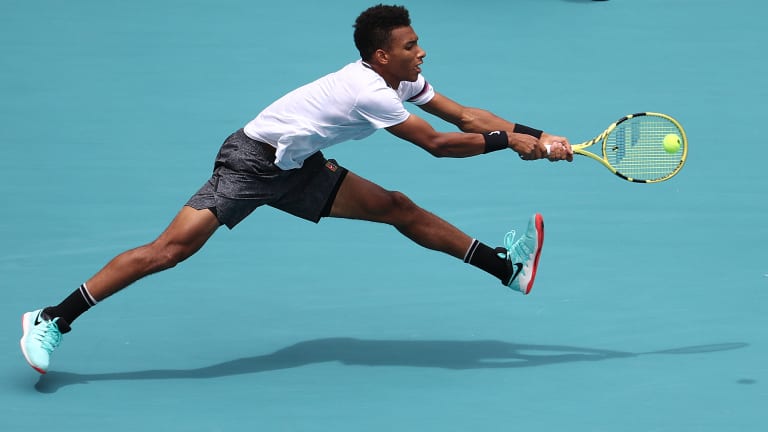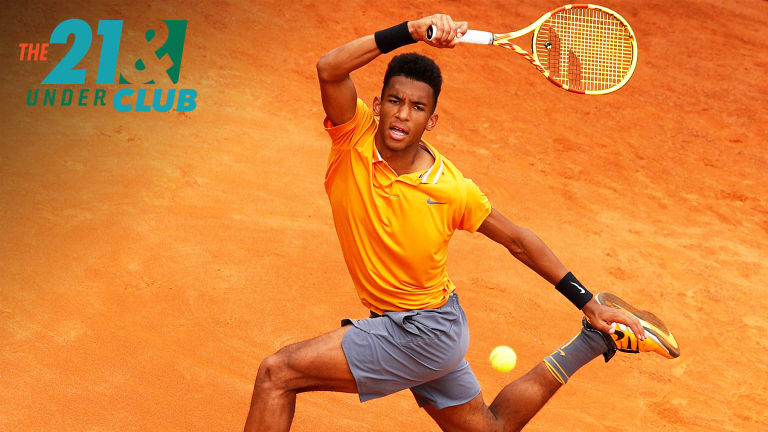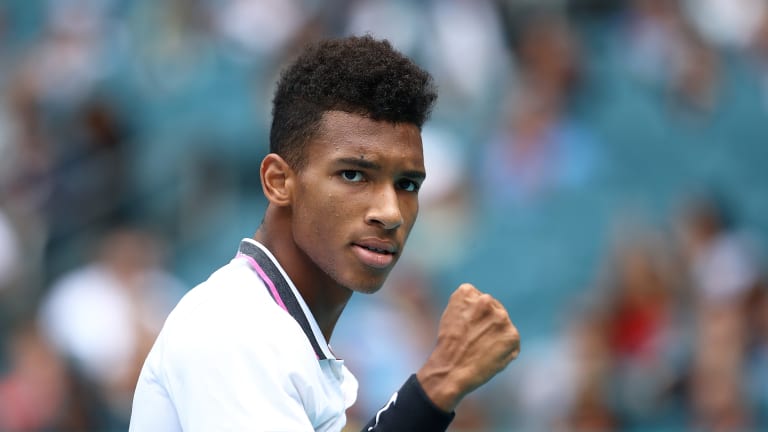The 21 & Under Club: Felix Auger-Aliassime
By Steve Tignor Jun 10, 2019ATP Munich, Germany
Cristian Garin repeats history by ousting Alexander Zverev in Munich quarterfinals
By TENNIS.com Apr 19, 2024ATP Monte Carlo, Monaco
Félix Auger-Aliassime previews Carlos Alcaraz second-round clash in Monte Carlo
By David Kane Apr 08, 2024Indian Wells, USA
Indian Wells men’s preview: Can returning champs Djokovic, Nadal fend off rising Sinner, Alcaraz?
By Steve Tignor Mar 05, 2024Social
Tour guide Hubert Hurkacz takes special Rotterdam guest around to meet ATP besties
By Baseline Staff Feb 18, 2024Social
Auger-Aliassime, de Minaur, Dimitrov, Korda, Sinner and Rublev tap in for viral 'of course' video trend
By Baseline Staff Feb 16, 2024Week In Preview
As Middle East swing begins, Ons Jabeur and Elena Rybakina seek to bounce back in Abu Dhabi
By Steve Tignor Feb 04, 2024ATP Montpellier, France
Comeback king Alexander Bublik rallies again, beats Felix Auger-Aliassime to reach Montpellier final
By TENNIS.com Feb 03, 2024ATP Montpellier, France
Felix Auger-Aliassime may love indoor hard courts more than anyone on tour
By TENNIS.com Feb 02, 2024Australian Open
Three to See, Australian Open Day 7: Ostapenko vs. Azarenka, Auger-Aliassime vs. Medvedev, Norrie vs. Ruud
By Liya Davidov Jan 19, 2024The 21 & Under Club: Felix Auger-Aliassime
He's only eighteen and has already cracked the ATP Top 30.
Published Jun 10, 2019
Advertising
How do you follow the Greatest Generation? It’s a question tennis has tried to answer for at least a decade. Serena, Roger, Novak, Rafa: all of them are over 30, and they’ve combined to win 75 Grand Slam singles titles—but none of them are going away quietly. When they do, who will fill their very large shoes?
As you’ll see in The 21 & Under Club, the future of tennis is still coming, and coming soon. While it may not produce a 20-Slam winner, it’s clear that the game will be in good hands. Interesting hands, too: one thing we know for sure is that this new generation of players will infuse the tours with a wide and refreshing range of styles, personalities and backgrounds. When the Greatest Generation says goodbye, we can feel good about welcoming this cast of players to the courts.
Canadian tennis is having a moment. Lots of them, actually. At times this spring, it felt as if players from the Maple Leaf nation were having all the moments.
Felix Auger-Aliassime, 18 and seemingly going on 25, reached a final in Rio de Janeiro and a semifinal in Miami, and has made a comet-like race up the rankings. After starting the season at No. 109, he had cracked the Top 30 by the end of April. Along the way, Auger-Aliassime wowed fans and flummoxed veteran opponents with his technical proficiency and emotional self-control. A new FAA was suddenly vying for control of the airspace.
Bianca Andreescu, also 18, somehow managed to top Auger-Aliassime when she beat four Top 20 opponents to win one of the WTA’s most prestigious titles in Indian Wells. She vaulted herself from No. 178 to No. 23, and showed off a canny, wide-ranging game and a theatrical moxy that led The New Yorker’s Gerald Marzorati to say that watching the rookie was “like watching Clayton Kershaw pitch.”
Denis Shapovalov, 19, cheered on his two young compatriots while they stole the headlines from him in Indian Wells. Then he stole them right back in Miami, when he out-gunned fellow Next Gen stars Stefanos Tsitsipas and Frances Tiafoe to reach his first ATP Masters 1000 semifinal. With that result, Shapovalov reached a career-high ranking of No. 20, and reminded everyone that he has the leaping athleticism to someday win major titles.

The 21 & Under Club: Felix Auger-Aliassime
© Getty Images
Advertising
Milos Raonic, 28, could have been forgiven for feeling like the odd—and old—man out in this youth revolt. But the player who, along with Eugenie Bouchard, put Canadian tennis on the map earlier this decade, and who reached the Wimbledon final as recently as 2016, underwent his own resurgence to start the year. He beat Nick Kyrgios, Stan Wawrinka and Alexander Zverev to reach the Australian Open quarterfinals, then went a round further at Indian Wells. Ranked No. 16,
Raonic remains his country’s best player nearly a decade after his debut By April, Canada, a country of 37 million, had the same number of players—three—in the ATP’s Top 40 as the United States, a country of 327 million. In tennis circles, “O Canada” had turned to “Woah, Canada.”
Which might lead a fan to ask: Why Canada?
Before we try to answer that question, let’s start with a quick quiz: How would you expect the head of Canada’s tennis federation, when asked to exp-lain his country’s sudden rise to powerhouse status in 2019, to respond?
(1) By claiming full credit for it?
(2) By extolling the brilliance of the centralized coaching system he installed a decade ago?
(3) By deflecting all the praise onto the players themselves, and downplaying the federation’s role?
If you chose answer 3, you have a pretty good idea of how things traditionally work north of our border.
“I think, before anything else, you have to acknowledge what the kids and their families have done,” says Michael Downey, president and CEO of Tennis Canada, when asked about the successes of Andreescu, Auger-Aliassime and Shapovalov. “They all took their own pathways.”
There’s no arguing that. In customary Canadian fashion, the country’s players hail from vastly different backgrounds, and they grew up on both sides of the nation’s Anglo-French divide. Shapovalov was born in Israel and raised outside of Toronto, where he was taught by his mother, Tessa, a high-level player from Russia. Auger-Aliassime, whose father is from Togo, grew up outside of Quebec City and trained in Montreal. Andreescu was born near Toronto, but took up the game at age 7, at a time when she was living with her parents in their native Romania. Raonic was born in Montenegro, is of Serbian descent, and came to Canada at age 3 with his parents Vasek Pospisil, a Wimbledon doubles champion and former Top 25 singles player, was born in British Columbia to parents who escaped their native Czechoslovakia during the Cold War.

The 21 & Under Club: Felix Auger-Aliassime
Advertising
If there’s one thing that unites this diverse group, it’s their status as the children of immigrants. To Downey, this is also what helps them thrive in a global sport, and what makes them truly representative of their country.
“Their parents came to Canada for a better life, and they’ve been shaped by the world,” Downey says.
“I think it’s a reflection of the mosaic nature of Canada. Immigrants hold onto their traditions, and we celebrate them. Tennis is a popular sport in a lot of the countries these kids came from, and they’ve kept up that tradition.”
The playing styles of the Canadian pros are equally heterogenous. From Auger-Aliassime’s textbook precision, to Andreescu’s thoughtful versatility, to Raonic’s serve-based attack, to Shapovalov’s daredevil shotmaking, there’s nothing cookie-cutter or one-dimensional about tennis in Canada. Yet at the same time, there’s nothing unorthodox, either; all of the country’s players are well-schooled in technique.
And that’s where the other side of the Canadian success story begins.
Along with the cultivation of diversity, which comes naturally in such a pro-immigrant country, Tennis Canada also set out to install a centralized national coaching system. The initiative began 15 years ago, when the federation received government funding for a new training center in Montreal, and began searching for someone to run it. The logical choice, for cultural and practical reasons, was to look across the Atlantic to France.
“It’s hard not to see the FFT [French Tennis Federation] as a best-practice example of a national training system,” Downey says. “We thought, ‘Why not go to a country that has done it so well?’”
France has long been known for the quality of its coaching. A high percentage of its population plays the sport, and instructors at all levels must pass a rigorous examination to be certified. The result is a deep well of technical knowledge, and an equally deep appreciation for the history and artistry of the game. While the FFT hasn’t produced dominant champions, it has churned out a long line of stylish, crowd-pleasing, highly individualistic players, from Jo-Wilfried Tsonga to Gael Monfils to Richard Gasquet to Amelie Mauresmo to Alize Cornet.

The 21 & Under Club: Felix Auger-Aliassime
© Julian Finney/Getty Images
Advertising
With that tradition in mind, in 2006 Tennis Canada approached one of the FFT’s leading coaches, Louis Borfiga, about heading up the new national training center in French-speaking Montreal. Borfiga had been instrumental in developing France’s Davis Cup-winning generation—and best of all for Canada, he was ready for a change.
“Louis is a man of few words, but he brings a quiet confidence to everything he does,” Downey says. “He has built a phenomenal team-first culture with the coaches and players at the national center.”
In an interview with Canadian tennis journalist Tom Tebbutt last fall, Borfiga explained his reasons for leaving Paris and starting over in Montreal.
“It was to have a new challenge,” he said, “and also the chance to be the boss and to initiate a policy. As well, it’s obvious that the attraction of Canada was the goodness of the Canadian people. That’s what made me decide, because to have my job you also have to be sentimentallyattached to the country.
But while you can take the coach out of Paris, you can’t take Paris out of the coach. One of Borfiga’s first and most important moves at Tennis Canada was to install European-style red-clay courts at the training center.
“They were on the second floor of a garage with open doors, and it was windy as hell,” Downey says. “But Louis said, ‘Hey, that’s what the players need to learn to deal with.’”
Borfiga believed that clay, which teaches patience and gives players a chance to learn to construct points, was a good surface for junior development. Auger-Aliassime appears to be in the process of proving him right. This year, the 18-year-old clinched Canada’s Davis Cup qualifying tie on red clay, and reached his first ATP final on the surface, in Rio.
The young Canadians have also benefited from the lineup of coaches that Borfiga has brought from France.
Auger-Aliassime works with Guillaume Marx and Frederic Fontang. Felix and Bianca have both been taught by Andre Labelle, who has a reputation as one of the sport’s best technical instructors. Andreescu is now coached by Sylvain Bruneau, who has been Canada’s Fed Cup captain. When Andreescu looked like she was on the verge of a breakdown in the Indian Wells final, against Angelique Kerber, Bruneau found the perfect positive words to carry her through it.
Has Canada hit upon a system that will keep pumping out world-class players in perpetuity? That’s hard to say. In the 1970s and ’80s, Sweden also seemed to have cracked the junior development code; since 1992, though, the home of Bjorn Borg, Mats Wilander and Stefan Edberg has just a single major singles title to its name.

The 21 & Under Club: Felix Auger-Aliassime
© 2018 Getty Images
Advertising
A system will only take a nation so far; ultimately, it depends on the talent of the players, and their willingness to make the most of it. Right now, Canada’s young pros profit from an mix of competitiveness and camaraderie, which comes with playing for asmall nation (in population) that’s striving to prove itself on a world stage.
“I think competition was a big thing,” Raonic said this spring. “Me and Vasek being the same age, we always competed. And now we have Felix and Denis competing against each other.”
Downey adds, “Felix and Denis trained in different places, but their friendship is what has helped them feed off each other’s success.” Shapovalov agrees: “It’s been kind of almost a rivalry with me and Felix,” he said in Miami, “and I feel like we have been able to thrive on each other’s results and push each other.”
When Andreescu joined Shapovalov and Auger-Aliassime in the spotlight, Canada was no longer the nice little tennis nation up north; it had become a force. As Andreescu said with a grin this spring, “We’re killing it.” Canada’s moment has only just begun.